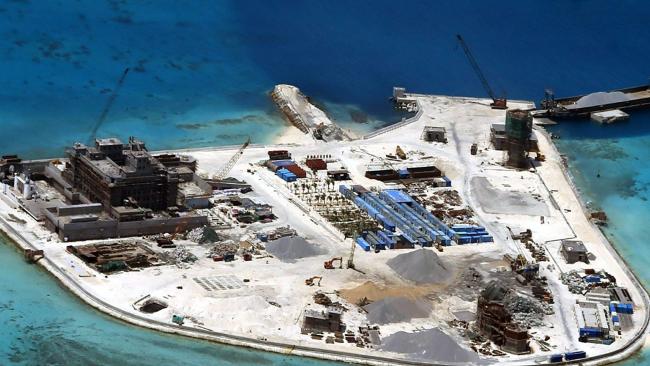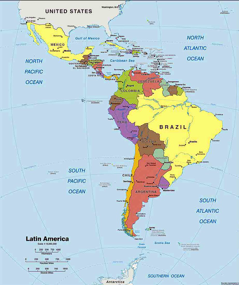Since the end of Second World War, the United States has been the leading military and economic power not just in the Americas, but in the world. This status is being challenged on an almost daily basis by a nation amassing more and more global power. According to the Yale Economic Review, China’s economy has been accelerating at a growth rate in the double digits.1 This presents a great concern for many involved in American foreign policy. A question persists: is China a friend or a foe of the United States? For many years, the fast-growing Chinese economy was troubling, but in recent years, the Chinese have also increased their military power by their amplified presence in the South China Sea. A few years ago, China made the unprecedented move of militarizing the South China Sea by constructing man made islands in the area over the Spratly Islands.2 Not only is the prospect of a more agile Chinese military a grave threat, but what does this mean for Chinese territorial waters? Does creating installations on artificial islands extend Chinese territorial claims into international waters? This question has been worrying many in foreign policy and leads to the second question of how can the U.S. prevent further encroachments by China? Fortunately, the UN Convention on the Law of Sea has the answer.3

Beginning in 2014, Chinese President Xi Jinping ordered his military to begin militarizing small patches of land in the South China Sea that are collectively called the Spratly Islands.4 The Spratly Islands are home to a wide array of oceanic life and are claimed not just by China, but also by the Philippines and Vietnam. President Xi Jinping refused to let these conflicting claims deter him from making his country’s military presence in the area greater and more mobile. Chinese military engineers began covering various islands in tons of additional sand to build them up and make them more stable. After this step, the Chinese military built communications towers and then, frighteningly, they constructed missile silos on these islands. China is also making sure no fishermen from the Philippines, nor individuals from any other nation come close to the artificial land masses.5. The United States’ Navy has performed many drills in the region that were harshly denounced by China who claims that the US Navy is threatening its sovereignty. This raises a series of other questions, however, as several other nations are declaring that the Spratly Islands fall within their exclusive economic zones.
According to the 1982 UN Convention on the Law of the Sea, territorial waters originate at a nation’s coastal baseline, which is the low water mark of a country’s ocean, and extend outward a distance of twelve nautical miles, or 13.8 land miles. Exclusive economic zones occur beginning at this baseline of territorial waters and extend two hundred nautical miles outwards. In addition to this clause, article 60 of the UN Convention states that as long as it is within a nation’s exclusive economic zone, the construction of artificial islands and their maintenance is sanctioned.6 This would seem as though it would settle the matter, but the primary issue is that while the Philippines, Malaysia, Brunei, and Vietnam are all claiming that the Spratly Islands lie within their exclusive economic zones, China is saying that historically, this region of the South China Sea belonged to them. They claim this because the waters used to belong to them, and their fisherman continue to fish there. China is frequently increasing the number of navy ships that patrol the islands to ensure that no other country can challenge their hold on the area. The Chinese government believes that since their fishermen and military have been using the islands for centuries, they possess a natural claim to them, despite what other nations say.7 Understandably, this poses a significant threat to the United States as China is already an economic powerhouse with a military that has increased its maneuverability. Hence, the reason why the United States’ government has been sending portions of its naval fleet to patrol the seas and routinely survey the area to see what China’s next move will be.

Actions like these are what make foreign policy experts wary of whether China is an ally rising up, or an enemy growing in both military and economic strength biding its time.8 The UN Convention on the Law of the Sea states explicitly that artificial islands in no way extends a nation’s territorial waters.9. While this may be the case, China does not seem to mind militarizing them and driving away anyone who gets too close to the Spratly Islands. When attempting to answer the China question, one must be cautiously optimistic. With their robust economy and the fact that they are major trading partners with the U.S., it is important not to automatically assume that they are a threat that must be dealt with. While it is not yet clear what China’s true intentions are, the Chinese nation presents at its best, a bullying and assertive friend, and at its worst, a belligerent and dangerous adversary.
- Sharon Yin, “Economic Growth and the Imbalance of Wealth Distribution in China ” Yale Economic Review, (March 11, 2013), accessed February 14, 2018, http://www.yaleeconomicreview.org/archives/378. ↵
- Sharon Yin, “Economic Growth and the Imbalance of Wealth Distribution in China,” Yale Economic Review, (March 11, 2013), accessed February 14, 2018, http://www.yaleeconomicreview.org/archives/378. ↵
- United Nations, The United Nations Convention on the Law of the Sea, (10 December, 1982) Montego Bay, 1982, http://www.un.org/depts/los/convention_agreements/convention_overview_convention.htm. ↵
- Mike Ives, “The Rising Environmental Toll of China’s Offshore Island Grab,” Yale E360, (October 10, 2016), accessed February 08, 2018, http://e360.yale.edu/features/rising_environmental_toll_china_artificial_islands_south_china_sea. ↵
- Mike Ives, “The Rising Environmental Toll of China’s Offshore Island Grab,” Yale E360, (October 10, 2016), accessed February 08, 2018, http://e360.yale.edu/features/rising_environmental_toll_china_artificial_islands_south_china_sea. ↵
- United Nations, The United Nations Convention on the Law of the Sea, (10 December, 1982) Montego Bay, 1982, http://www.un.org/depts/los/convention_agreements/convention_overview_convention.htm. ↵
- Suzanne S. Kimble, 2015, “Is China Making Waves in International Waters by Building Artificial Islands in the South China Sea?.” Tulane Journal Of International & Comparative Law 24, no. 1: 263-289, Legal Collection, EBSCOhost (accessed February 18, 2018). ↵
- Steven Stashwick, “China Signaling it May Finally ‘Militarize’ the South China Sea Officially.” The Diplomat, January 25, 2018. Accessed January 30, 2018. https://thediplomat.com/2018/01/china-signaling-it-may-finally-militarize-the-south-china-sea-officially/. ↵
- The United Nations Convention on the Law of the Sea, (10 December, 1982), Montego Bay, 1982, http://www.un.org/depts/los/convention_agreements/convention_overview_convention.htm ↵



39 comments
Samuel Stallcup
There’s an episode of South Park where Cartman feels that China is going to invade after seeing the Beijing Olympics opening ceremony. He becomes so hysterically worried that he dresses up as a Chinese boy and goes to a P.F. Changs to “become” one of them. After seeing that it was a normal and Americanized restaurant, he gets even more worried. Even though many people certainly don’t feel this way, this article gave me a good perspective on why someone could feel that way. Great article!
Miguel Camarillo-Cohen
Great read! The author takes a very methodical approach in describing not only the U.S.’s relationship with China but the other countries surrounding the Spratly Islands. I was unaware that the UN Convention on the Law of the Sea of 1982 states that “territorial waters originate at the nation’s coastal baseline… and extends outward a distance of 12 nautical miles or 13.8 land miles.” If this is the case, how can China legitimately claim the Spratly Islands if Hong Kong is approximately 813 miles away.
Ana Gonzalez
The author chose a very relevant topic to write about and did a good job of incorporating and simplifying the UN Convention on the Law of the Sea. The excuses that these countries use for demanding ownership like the “we have been here longer” justification, is one that is difficult to back up, but I guess what matters is if the country push others out of its way, as China is doing. Very well-written article and I hope that China turns out to be just an ally rather than an enemy!
Miranda Alamilla
Although the title was a bit vague in comparison to the article and didn’t really prepare the reader for the journey they were about to embark on, the author did a great job in clearly stating their points throughout their article. I really like that they brought in the UN Convention on the Law of the Sea because it was very relevant and helpful. I didn’t know that territorial waters start at the coastline and extend from there 12 nautical miles, and I think that that was a key piece of information to include. Great article!
Natalie Childs
This was a good and really informative article. Before reading the article, I had not known much about the UN Convention on the Law of the Sea, and think that the article did a really good job of explaining it and showing how it is relative to events that are happening now. The only suggestion I have is that the title was a little broad, and didn’t highlight the discussion of the events happening in the water.
Hanadi Sonouper
I found this article to be very interesting and different than what I expected, that author did a great job at illustrating the growth of china over the last couple of years. I would have never expected that their growth has implemented them to take actions to build smaller islands along the southern sea. It was a good contrast against our nation to see a different point of view of how other countries revolutionize and implement a greater economic growth.
Matthew Wyatt
Though the subject matter is timely and important, the tone of the article seems in conflict with the intention. The title, as well as the introduction and conclusion, suggest that the article is meant to explore whether China is a “friend or foe” to the United States, and yet the language used seems to indicate a forgone conclusion that they are the latter. Words like “grave threat” and “frighteningly” belie the impression of objectivity that an article like this should strive for. Utilizing more objective language will increase the power of your article and allow your reader to decide for themselves whether or not China’s actions can be viewed as adversarial.
Yahaira Martinez
i really enjoyed reading this article because it was very informative. Im not very well informed about international affairs but by reading this i learned alot about China and the reasons why we should and shouldn’t be worried and like that the article had a very neutral tone about the subject and wasnt siding with either ally or foe.
Cristina Cabello
I find it really crazy how china is over populating. They were required to only have one child. Then they wanted more males out of those children. But now they have a low percentage of women. So their problem with population is even bigger now. The whole military and war talk reveals how troubled our society is. But in the end everything will somehow work out for everyone. This is a good story about how different China is compared to us. But then we are both in a way still able to compromise.